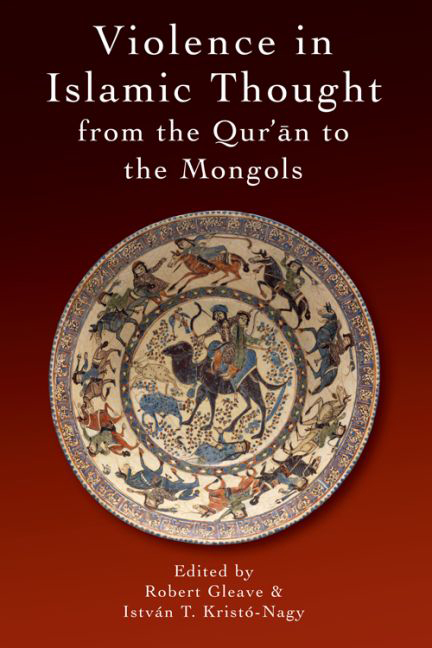Book contents
- Frontmatter
- Contents
- Dates and Abbreviations
- List of Figures and Tables
- 1 INTRODUCTION
- PART I JIHĀD AND CONQUEST: ATTITUDES TO VIOLENCE AGAINST THE EXTERNAL ENEMIES OF THE MUSLIM COMMUNITY
- PART II THE CHALLENGED ESTABLISHMENT: ATTITUDES TO VIOLENCE AGAINST THE STATE AND IN ITS DEFENCE WITHIN THE MUSLIM COMMUNITY
- 6 WHO INSTIGATED VIOLENCE: A REBELLING DEVIL OR A VENGEFUL GOD?
- 7 ATTITUDES TO THE USE OF FIRE IN EXECUTIONS IN LATE ANTIQUITY AND EARLY ISLAM: THE BURNING OF HERETICS AND REBELS IN LATE UMAYYAD IRAQ
- 8 ABBĀSID STATE VIOLENCE AND THE EXECUTION OF IBN ĀISHA
- 9 THE SULTAN AND THE DEFIANT PRINCE IN HUNTING COMPETITION: QUESTIONS OF LEGITIMACY IN HUNTING EPISODES OF ṬABARISTĀN
- PART III LUST AND FLESH: ATTITUDES TO VIOLENCE AGAINST THE DEFENCELESS, INTRA-COMMUNITARIAN VIOLENCE BY NON-STATE ACTORS
- Bibliography
- Index of Qurānic Citations
- General Index
9 - THE SULTAN AND THE DEFIANT PRINCE IN HUNTING COMPETITION: QUESTIONS OF LEGITIMACY IN HUNTING EPISODES OF ṬABARISTĀN
from PART II - THE CHALLENGED ESTABLISHMENT: ATTITUDES TO VIOLENCE AGAINST THE STATE AND IN ITS DEFENCE WITHIN THE MUSLIM COMMUNITY
Published online by Cambridge University Press: 15 September 2017
- Frontmatter
- Contents
- Dates and Abbreviations
- List of Figures and Tables
- 1 INTRODUCTION
- PART I JIHĀD AND CONQUEST: ATTITUDES TO VIOLENCE AGAINST THE EXTERNAL ENEMIES OF THE MUSLIM COMMUNITY
- PART II THE CHALLENGED ESTABLISHMENT: ATTITUDES TO VIOLENCE AGAINST THE STATE AND IN ITS DEFENCE WITHIN THE MUSLIM COMMUNITY
- 6 WHO INSTIGATED VIOLENCE: A REBELLING DEVIL OR A VENGEFUL GOD?
- 7 ATTITUDES TO THE USE OF FIRE IN EXECUTIONS IN LATE ANTIQUITY AND EARLY ISLAM: THE BURNING OF HERETICS AND REBELS IN LATE UMAYYAD IRAQ
- 8 ABBĀSID STATE VIOLENCE AND THE EXECUTION OF IBN ĀISHA
- 9 THE SULTAN AND THE DEFIANT PRINCE IN HUNTING COMPETITION: QUESTIONS OF LEGITIMACY IN HUNTING EPISODES OF ṬABARISTĀN
- PART III LUST AND FLESH: ATTITUDES TO VIOLENCE AGAINST THE DEFENCELESS, INTRA-COMMUNITARIAN VIOLENCE BY NON-STATE ACTORS
- Bibliography
- Index of Qurānic Citations
- General Index
Summary
The provinces of Northern Iran, the region south of the Caspian Sea, had a particular role in the Arab conquest of Iran. Their geographical isolation, mountainous regions, steamy and often intolerable sub-Mediterranean climate and thick forests caused many difficulties for the early Muslim conquerors in the seventh century AD. The Abbāsid empire could only penetrate into the mountains of Ṭabaristān and the valleys of Māzandarān in the second half of the eighth century.
In this chapter, I analyse some legends concerning the early Islamic period of the central provinces of the Caspian regions Ṭabaristān and Māzandarān. On the basis of some of the evidence, it seems that these stories could be linked with the myths of the last pre-Islamic Iranian empire – that of the Sāsānians.
ṬABARISTĀN IN THE SEVENTH–NINTH CENTURIES AD
In the early Middle Ages, the province now called Māzandarān was divided into two main regions. Its inner, mountainous zone was generally called Ṭabaristān, while the very narrow, coastal plain and the surrounding hills and gentle slopes were Māzandarān. In other words, there were two main regions within this province: the kūhistān or jabalīyya and the sāhil. The name Ṭabaristān disappeared from the historical sources after the Mongol conquest of Iran in the thirteenth century, thus the name Māzandarān became predominant up to the present day.
The history of Ṭabaristān differs in many ways from the early Islamic history of other Iranian provinces. Due to its ‘splendid isolation’, this province was an ideal retreat for numerous political movements and religious minorities.
During the late Sāsānian period and the first decades of Islam, this situation was much the same as before. After their defeat, the Mazdakites took shelter in Ṭabaristān in the sixth century, and following the Arab invasion of the Sāsānian empire in the middle of the seventh century, a considerable part of the Sāsānian aristocracy escaped to Ṭabaristān. Some of these aristocrats exploiting the local geographical circumstances succeeded in governing this land for many centuries and only nominally accepted the authority of the frequently changing superior powers. Due to these archaic conditions, not only did the political structures, titles and religious trends (i.e. Zoroastrianism) deeply rooted in the Sāsānian past survive tenaciously, but in the cultural domain, too, this region was strongly connected to pre-Islamic times.
- Type
- Chapter
- Information
- Violence in Islamic Thought from the Qur'an to the Mongols , pp. 141 - 152Publisher: Edinburgh University PressPrint publication year: 2015



